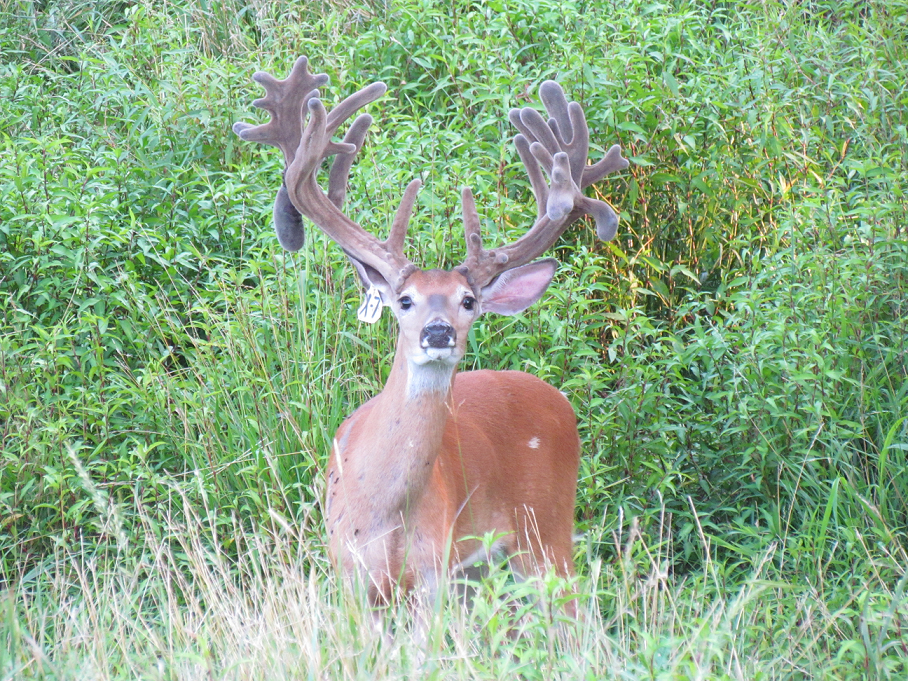
Roughly 25 years ago my whitetail passion led me to acquire a small herd of captive whitetails. My goal at that time was simply to learn as much as possible about whitetail deer in an effort to become the best deer hunter that I could possibly be. Yesterday I hauled off the last 4 captive deer that remained in my herd and delivered them to their new owner. While I was glad to see them go, I do not regret having them and caring for them daily over the past two and a half decades. Without a doubt the lessons these deer taught me have been invaluable and directly led to my success in the whitetail woods.
These photos from more than 20 years ago show my earlier efforts to learn as much as possible about whitetails through my captive research herd.
The first deer I had was a pair of 2-day old doe fawns that we named Abby and Annie. Right from the start these fawns started opening my eyes and teaching me new information that I took to the woods. We kept Abby and Annie in a small building for the first weeks of their life and bottle-fed them several times a day. Interestingly, when we would go to feed them they would always be bedded in the same corners of the shed. Abby had her corner and Annie had hers. Through at least a couple of hundreds feeding visits over several weeks, neither fawn bedded anywhere except its preferred corner even a single time!
This led me to the theory that individual deer have specific preferred beds. Now I am not suggesting that a wild deer is going to bed in the exact same spot every day, however I do believe that individual bucks have very specific beds they prefer under similar situations such as time of year and wind direction. This is something that I have seen play out many times in the wild in the decades since. For example, if I notice a young buck bedding at a certain spot in the early season on days with a southerly wind, I expect that buck is likely to be doing the same under similar conditions in following years.

For the past 25 years I have been able to look out my kitchen window at any time and see sights such as this. Without a doubt my captive research herd has made me a much better deer hunter and much more knowledgeable about whitetails than I would have ever been without them.
After I had the captive deer for a few years I started getting very specific with my studies and focused my efforts on learning more about nutrition and antler genetics. The things I learned along the way would take a book to share in detail but I will briefly highlight a few items here.
Nutrition –

My captive bucks taught me the importance of having a high-quality foodsource as early as possible in the spring. Today I strive to have clover and alfalfa on each property that I manage as these plants are packed with important nutrients and green up very early in the spring.
Genetics –
Many hunters think that giant bucks sire sons which are also much larger than “normal”, however my research with captive deer proved to me that giant bucks like this are more often the result of superior does which pass these antler genetics on to their sons.
As mentioned earlier, I could literally write a book on the lessons I have learned from my captive research whitetails over the past 25 years. Without a doubt this experience has made me a better hunter and greatly expanded my knowledge regarding whitetails. One thing that has really struck me over the years is how much mis-information is bantered about as gospel within the deer hunting community. Here is a short list of misinformation that is commonly accepted as fact but which my captive deer revealed to be false.
Changes in Rut Timing – The idea that the timing of the rut changes (even slightly) from year to year is simply false. For 25 years my captive fawns were born the same time each spring reinforcing the fact that the rut happens at the same time every fall no matter what the magazines say.
Post-Rut Buck Feeding Activity – There is a commonly held belief that after the rut bucks will increase feeding activity to replenish weight lost during the rut. I have never witnessed this with captive bucks which also lose a lot of weight during the rut. After the rut a buck’s metabolism has naturally slowed and feed intake will NOT noticeably increase. It will be spring before feed intake increases and bucks start regaining lost weight.
The Second Rut – The idea that about a month after the November rut a less intense “second rut” takes place is completely false. There is only one rut each year and although there will be breeding activity after November, it will be random and based primarily around doe-fawns entering their first estrous cycle. This is all part of a typical whitetail rut. There is no “second rut”!
This brief summary barely touches on a few of the many things my captive research whitetails have taught me over the last 25 years. While I am glad that I no longer have the captive deer to care for and have moved on to another chapter in my life, I do not regret having them as they taught me things that I never could have learned any other way. Probably the most important thing I learned was to question everything I read or hear regarding whitetails. There literally is as much false information being spread as there is good factual material. The more I learn about whitetails the more I realize just how little I really know.